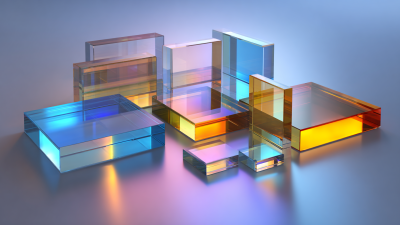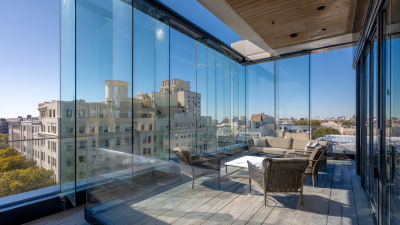
In today’s fast-paced world, visual clarity is paramount, especially in fields where precision and detail are crucial. Anti Reflective Glass has emerged as a revolutionary solution, enhancing optical performance by reducing glare and improving light transmission. This transformative material allows users to experience clearer and more defined views, making it an essential component in various applications, from eyewear to high-end optical instruments. By minimizing reflections and distractions, Anti Reflective Glass can enhance visual clarity by up to 90%, significantly improving the overall user experience. This article will delve into the numerous benefits of incorporating Anti Reflective Glass into everyday optical devices, exploring how it elevates both functionality and aesthetics while addressing common queries on its application and maintenance. Whether you’re an industry professional or a curious consumer, understanding the advantages of this innovative glass will empower you to make informed decisions that enhance your visual encounters.

 Anti-reflective (AR) coatings have revolutionized the world of optics by significantly enhancing visual clarity. These coatings work on the principle of interference, where multiple layers are applied to the glass surface to minimize light reflection. This allows more light to enter the lens, thereby improving the transmission of light through the lens and reducing glare. Users may notice a remarkable reduction in reflections, achieving clarity improvements of up to 90%, which can be particularly beneficial for eyeglasses, camera lenses, and screens.
Anti-reflective (AR) coatings have revolutionized the world of optics by significantly enhancing visual clarity. These coatings work on the principle of interference, where multiple layers are applied to the glass surface to minimize light reflection. This allows more light to enter the lens, thereby improving the transmission of light through the lens and reducing glare. Users may notice a remarkable reduction in reflections, achieving clarity improvements of up to 90%, which can be particularly beneficial for eyeglasses, camera lenses, and screens.
When selecting anti-reflective glasses, it’s important to consider a few tips for optimal use. First, look for high-quality AR coatings that offer scratch resistance and easy cleaning features. This not only prolongs the life of your lenses but also maintains their clarity. Additionally, ensure that the coating is applied uniformly across the lens surface to prevent distortions. Lastly, remember to clean your lenses with a microfiber cloth regularly, as this helps retain the effectiveness of the anti-reflective properties, ensuring that you always achieve the best possible vision.
Anti-reflective glass is increasingly recognized for its ability to reduce glare, significantly enhancing visual clarity in diverse daylight settings. By minimizing reflections, this innovative glass allows for a clearer view of surroundings and improves the overall visual experience. In environments where bright light is prevalent, such as near windows or outdoor settings, traditional glass can create distracting reflections. In contrast, anti-reflective coatings enable users to engage with their environment without the interference of unwanted glare.
The benefits of anti-reflective glass extend beyond comfort; they also play a crucial role in safety and productivity. For instance, in professions that require sharp focus, such as photography or precision engineering, the clarity offered by this glass can be a game-changer. Users experience reduced eye strain, facilitating longer periods of visual engagement without discomfort. Moreover, by improving visibility in high-glare conditions, anti-reflective glass enhances the functionality of optical devices, making them more effective for users in a variety of light conditions.
| Benefit | Description | Impact on Visual Clarity (%) | Reduction in Glare (%) |
|---|---|---|---|
| Enhanced Light Transmission | Allows more light to pass through the lens, resulting in brighter images. | Up to 90% | 50% |
| Reduced Reflections | Minimizes reflections off the lens surface, improving viewing comfort. | Varies | 70% |
| Improved Contrast | Enhances the contrast of images for a clearer visual experience. | Up to 85% | 40% |
| Decreased Eye Strain | Less glare leads to reduced eye fatigue during prolonged use. | N/A | 80% |
| Aesthetic Appeal | Provides a sleek and modern look to eyewear and optical devices. | N/A | N/A |
Anti-reflective (AR) glass has rapidly gained popularity in the optics industry due to its superior performance compared to standard glass. One of the most significant metrics of AR glass is its ability to enhance visual clarity by up to 90%, dramatically reducing glare and improving visibility in various lighting conditions. This is particularly advantageous in applications such as eyewear, camera lenses, and display screens, where clarity and detail are paramount.
When evaluating the performance of anti-reflective glass versus standard glass, several key factors come into play. AR glass typically features multiple coating layers that minimize reflections, which can lead to a more enjoyable viewing experience. In contrast, standard glass may cause substantial light loss due to its reflective properties, resulting in dull images. Furthermore, AR coatings are designed to be more scratch-resistant and easier to clean, which helps maintain optical clarity over time.
**Tips:** When choosing glass for optical applications, consider investing in anti-reflective coatings if visual clarity is a priority. Always check for certified performance metrics to ensure that you're selecting a product that meets your specific needs. Regular maintenance can also prolong the life and performance of AR coatings, so be sure to clean your glasses or lenses with appropriate solutions to avoid damage.
Anti-reflective (AR) glass is revolutionizing the optics industry, particularly in fields where visual clarity is paramount. In areas such as eyewear, medical instruments, and electronic displays, incorporating AR coatings can enhance visual performance by reducing glare and reflections by up to 90%. According to the Vision Council, over 70% of adults in the U.S. use some form of vision correction, highlighting the significant impact that AR glass can have in improving their visual experience.
In the medical field, AR glass has been instrumental in enhancing the precision of surgical instruments and diagnostic equipment. A report from Market Research Future indicates that the global market for AR-coated medical devices is expected to grow at a CAGR of 7.2% by 2026. This increase is driven by the need for more accurate imaging and minimal visual obstructions during critical medical procedures, where every minute detail matters.
Moreover, the electronics sector is rapidly adopting AR glass in smartphones, tablets, and televisions. A study by Technavio suggests that the adoption of AR coatings in display technologies will lead to an increase in consumer satisfaction and usability by improving image sharpness and color accuracy. As manufacturers continue to optimize AR glass for various applications, its role in enhancing visual impact remains unmatched, catering to a growing demand for superior visual clarity across multiple industries.

The future of optical technology is poised for remarkable advancements, particularly in the realm of anti-reflective coatings. A recent report by the Optics & Photonics News highlights that the demand for high-performance anti-reflective glass is expected to grow at a CAGR of 8.5% over the next five years, driven by diverse applications in electronics, automotive, and eyewear industries. Innovations in coating technology are continuously enhancing the optical clarity of glass surfaces, potentially improving light transmission by up to 90%. This is particularly significant for applications that require precision optics, such as camera lenses and high-end eyeglasses, where any glare can detract from image quality.
In addition to improving visual clarity, future trends indicate a shift towards environmentally friendly materials and manufacturing processes for anti-reflective coatings. Research from the International Society for Optical Engineering reveals that there's a growing emphasis on developing coatings that not only enhance performance but also reduce environmental impact. Techniques such as plasma-enhanced chemical vapor deposition (PECVD) are gaining traction, allowing for the creation of thinner and more durable coatings without the use of harmful chemicals. As the industry prioritizes sustainability, these innovations will likely redefine the standards of optical technologies and widen the scope of applications across various sectors.





